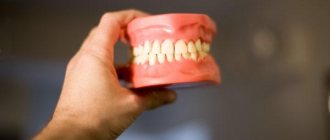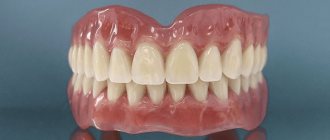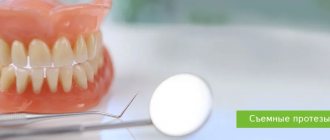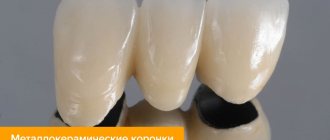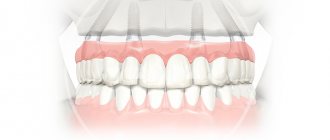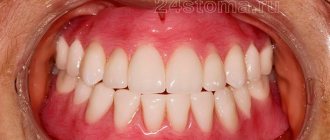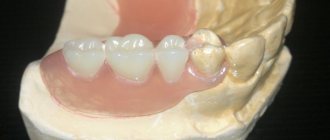In dentistry, complete or partial absence of teeth is called adentia. This pathology can be congenital (anomaly of the development of the dental system) or acquired. The disease is characterized by a violation of the continuity of the dentition. A person cannot chew, speak normally and experiences discomfort from a cosmetic defect in his smile. His diction and articulation are deteriorating, and his gastrointestinal tract is functioning worse.
Both complete and partial adentia are dangerous because, due to tooth loss, deformation of the facial skeleton and diseases of the temporomandibular joint (TMJ) are possible.
Types of pathology
In dentistry, adentia is considered as a primary or secondary defect of the dentition.
- Complete congenital adentia is extremely rare, occurring in approximately 1% of cases.
- Partial secondary adentia is diagnosed in 45–75% of cases.
- Also, complete adentia occurs in 25% of people over 60 years of age.
Depending on the causes and time of occurrence of the pathology, dentists, as mentioned above, distinguish between congenital and secondary tooth loss, as well as edentia of temporary and permanent rows. True adentia is the absence of a tooth germ, and when adjacent crowns merge and there is a delay in their eruption, dentists speak of false adentia.
Taking into account the number of missing teeth, partial and complete edentia are distinguished. The first involves a deficiency of up to 10 units of dentition, usually the upper lateral incisors, second premolars and third molars. If more than 10 teeth are missing, doctors diagnose multiple adentia.
Ask a Question
Which prosthetics for the lower jaw is better?
Patients are often interested in which prosthetics are best for restoring lower jaw teeth. Progressive experts believe that implantation and installation of structures today is the optimal and gentle option to maintain quality of life at any age. Root-shaped implants for the lower units are selected taking into account the upcoming high chewing load.
We use the basal method of prosthetics on implants extremely rarely and only at the stage of temporary prosthetics in the distal part as part of the “All on 6 implants” protocol in the absence of teeth, severe tissue atrophy and the inability to install 2 classical artificial roots. Then the elongated implants are introduced into the deep layers of the jawbone during the formation of bone in the distal section after bone grafting. After the bone tissue has formed, the basal implants are removed and normal classical implants take their place. And after this, the patient undergoes permanent prosthetics on 6 implants.
Modern implant designs are characterized by directional threading; some models have a porous surface with a coating that accelerates the integration of the artificial root into the bone. Fixed dentures in the absence of teeth are installed on a larger number of supports, minimum 6-8. One- or two-stage protocols are warranted. In the first option, until complete engraftment, the patient wears a traditional removable denture; in the second, a temporary option with artificial gums attached to pins is installed.
The fixed structure consists of metal-free crowns (usually zirconium dioxide), there is no artificial gum, and there is no need to remove the denture for cleaning. It is enough to follow standard hygiene procedures.
The “All on 4” protocol is ideal for restoring missing teeth in the lower jaw, if it is small, and allows, in most cases, to avoid bone augmentation. This is usually a one-stage implantation with immediate loading. Primary stabilization is high, there is an orthopedic stage. Within a week after the implants are inserted, a temporary prosthesis is put on.
If the bone has atrophied and for some reason it is decided to give preference to classical implantation, then bone grafting will be required. Special membrane materials are used that are embedded in the bone and stimulate its development. After osteoplasty there is a rehabilitation period of 4 months. up to six months.
Causes
The main and only cause of adentia is the absence or death of tooth buds. Primary pathology can be caused by heredity or provoked by various harmful factors acting during the formation of the fetal dental plate.
Complete congenital edentia is an extremely rare phenomenon. Formed due to ectodermal dysplasia. In this case, along with the absence of teeth, patients experience underdevelopment of hair, skin, nails, as well as sebaceous and sweat glands, eye lenses, and nerves.
Other common causes of pathology include the following:
- disturbance of mineral metabolism during the period of intrauterine development of the fetus against the background of diseases of the mother during pregnancy;
- illnesses in early childhood;
- heredity;
- disruption of the endocrine system;
- disruptions in the development of ectoderm - the outer germ layer of the embryo;
- treatment of concomitant diseases, including malignant neoplasms;
- chemotherapy, treatment with ionizing radiation;
- osteomyelitis and other purulent inflammations of the jaws.
The causes of secondary tooth loss in the process of life can be untreated caries, pulpitis, periodontitis, dental trauma, phlegmon, abscesses, illiterate provision of dental or orthopedic care, as well as other pathologies of the teeth and gums.
What are the causes of complete tooth loss?
You can lose all your teeth for several reasons:
- advanced caries. Untimely treatment of dental caries invariably leads to their destruction and the gradual removal of all teeth.
- gum disease, in particular periodontitis (meaning the extensive form (generalized), when all gums are affected by periodontitis). With severe periodontitis, the teeth become so loose that they can no longer be saved.
- injury. Teeth can be lost, for example, in a car accident, oral surgery, or other circumstances.
Complications
Adentia leads to a variety of physical and aesthetic complications:
- in the area where a tooth is missing, the unloaded bone gradually atrophies;
- the face may become asymmetrical, lip closure is disrupted, and the chin and nasolabial folds deepen. Often the position of the corners of the mouth changes, they begin to sink;
- underdevelopment of the jaws occurs. It is expressed more strongly the more teeth are missing, various dentofacial deformations appear;
- with multiple edentia of the lower jaw, its strong protrusion and deep bite are observed;
- with anomalies of the upper jaw, the lower dentition begins to overlap the upper one;
Underdevelopment of the jaws is not observed in all cases, and not all children and adults express it in the same way. However, in all cases, edentia leads to negative changes in appearance.
With complete or multiple edentia, the bite is formed incorrectly and the function of oral digestion is disrupted. The food is poorly crushed, and the patient is forced to give up many tasty dishes. We should not forget that with this pathology a person’s self-esteem decreases, he begins to worry about the fact that he looks unattractive, withdraws into himself and is less likely to make contact with people.
Edentia of the upper jaw
The upper jaw is more often than the lower jaw and is subject to various types of anomalies. As a rule, patients have symmetrical hypodentia of two teeth. And since the front teeth are involved in sound production and form the purity of pronunciation, this type of deformation is the most noticeable. The patient's speech becomes lisping and slurred, the smile “creeps away”, and saliva splashes.
Edentia of the lower jaw
The lower jaw has a small prosthetic bed, so when edentulous, the tongue begins to take the place of the lower teeth. As a result, the patient’s diction changes significantly and his well-being worsens.
Bone grafting for jaw implantation
The more implants are installed, the greater the likelihood that the existing bone tissue will not be enough to install implants and it will be necessary to build it up. Bone deficiency can be in thickness (very thin bone) or in height (close to the maxillary sinuses in the upper jaw, nerve in the lower jaw).
If there is a slight lack of bone tissue in thickness, one-step bone grafting with the installation of implants is possible. It is also possible to carry out a sinus lift (a type of bone tissue augmentation when the distance to the maxillary sinus is insufficient) with the one-step installation of implants.
If there is a large deficiency of bone tissue, operations are first performed to build it up (open sinus lift, harvesting and replanting of a bone block), and after 3-6 months, implantation is performed. In this case, the total duration of treatment can be from one to one and a half years.
Diagnosis and treatment
To diagnose the disease, the dentist needs a detailed examination of the patient’s oral cavity. The doctor asks the patient a number of things:
- causes and timing of tooth loss;
- information about previous diseases;
- data on dental prostheses previously used by the patient.
During the examination, the dentist notes the asymmetry of the face, the severity of the chin and nasolabial folds, the degree of reduction in the height of the lower part of the face, the presence of a jam, the nature of the closure of the lips, the topography of the transitional fold, the degree of mouth opening, the nature of the jaw relationship. The specialist also determines the presence of crunching in the joints, pain when moving the lower jaw and diagnoses the degree of atrophy of the alveolar processes.
The examination necessarily includes palpation of the oral cavity and radiography of the TMJ. Based on the data obtained, the doctor determines further treatment tactics (prosthetics), selects the appropriate type of prosthesis and impression material for the patient.
Treatment of adentia in children
It is important for parents to understand that treatment of children who experience pathological tooth loss must be carried out without fail. For example, if a child lacks primary teeth in the anterior and lateral segments, the row may not form correctly during adolescence.
Children's adentia is characterized by:
- delay in changing permanent teeth;
- asymmetrical teething;
- unilateral preservation of primary teeth;
- non-loss of a baby tooth and its fusion with a depression in the jaw bone.
If at least one of these signs is detected, the child should definitely be shown to an orthodontist.
The choice of orthopedic design depends on the type of pathology and the condition of the small patient’s oral cavity. Children most often have fixed bridges installed - cantilever or sliding. To fix the structure, crowns are installed. Children respond well to prosthetics and adapt well to new designs.
Bridges can also be installed in young patients, but such designs are more suitable during the period of late mixed and permanent dentition. The most successful designs are considered to be sliding bridges. The only drawback of such a system is the formation of a gap when the structure moves apart and food gets into it.
Bridges are sometimes installed for preventive purposes to preserve space in the dentition.
During the period of early mixed and temporary dentition, removable plate dentures are used, which do not retard the growth of the jaw bones.
Treatment of adentia in adults
Adult patients are offered various types of removable and fixed dentures. Prosthetics on implants, installation of bridges on four implants and other prosthetic options at the patient’s choice are possible. Depending on the condition of his dental system, financial capabilities and wishes, dentists, as a rule, offer several treatment options to choose from.
When choosing a treatment method, it is important to understand the features of each design. The doctor, based on the condition of the patient’s oral cavity, offers him a choice of several prosthetic options.
Removable dentures
Partial or complete dentures should be replaced every 1.5 to 2 years. Therefore, even with complete loss of teeth, dentists offer an alternative type of prosthetics based on implants.
Clasp dentures
Dentures on a metal frame, on which an acrylic base is installed, and artificial teeth are installed on it. This solution makes it possible to significantly lighten the design of the prosthesis, making it thinner and more comfortable.
Bridges
In case of partial edentia, it is possible to install bridges. The non-removable structure is fixed on adjacent non-grindable teeth.
Implant-supported prosthetics
Implant-supported prosthetics are considered the most reliable and aesthetic way to restore dentition. The main advantages of this type of bone implantation include:
- long service life of the structure;
- aesthetic appearance;
- no need to grind adjacent teeth.
A denture installed on implants completely replaces missing teeth and performs a functional and aesthetic task.
Features of implantation and prosthetics on the lower jaw
The artificial root is more firmly fixed in the tissue, so the risk of rejection tends to zero. The mandibular bone atrophies more slowly after the loss of units, which reduces the likelihood of osteoplasty. For complete dental prosthetics on implants, we use the “All on 6” technique more often in most clinical cases. This guarantees the patient reliability and ease of use of the orthopedic construction, primarily in the long term.
The aesthetic side is important, but when working with the dental row below, more attention is paid to restoring functionality. There is a nuance: the surgeon’s work will require precision, since the trigeminal nerve passes at the base of the jaw and there is a risk of damage to it if the intervention is careless.
- Before implantation begins, during diagnostics the exact location of the branch of the trigeminal nerve is established, the structure of the tissues and the localization of nerves and vessels are clarified.
- Surgeons at the Research Center clinics are highly qualified, carry out diagnostics and know everything about the anatomical features of each patient, so implantation takes place without complications.
- The doctor selects not only the location of the implant, but also its size, which is especially important in the absence of teeth. If the location is too close, then the nerve trunk will need to be docked.
Example #5 - Lower jaw prosthetics on 6 implants ALL ON 6
Our patient is a woman with fairly progressive views on dental treatment and prosthetics. But a rather serious problem in her life is an allergy to antibiotics. Since she categorically did not want a removable denture, considering it archaic and uncomfortable, the patient began her independent attempts to improve her smile. And she did this at her own peril and risk in several clinics.
At first, she installed the implants without “covering up”—the subsequent use—of antibiotics. Some of the implantation went well, some not so much. Having suffered, the patient concluded that she still needed to turn to professionals and then, even without antibiotics, she would get the reliable and aesthetically beautiful result that she dreams of and really wants to achieve.
The photo shows a view of 6 implants installed on the lower jaw:
Photo after prosthetics
:
You can read more about this interesting clinical case HERE.
Prevention of edentia
The best prevention is competent, timely oral care. Regular brushing of teeth and gums, preventive examinations at the dentist twice a year, giving up bad habits, switching to a balanced diet - all this will help keep your teeth healthy and strong for as long as possible.
If you or your child is experiencing this disease, do not delay visiting the dentist. Experienced therapists, orthopedists and implantologists at STOMA clinics will help solve the problem of partial or complete absence of teeth: they will select a comfortable and aesthetic prosthesis that will significantly improve the quality of life, make you more confident and beautiful.
Call and make an appointment by phone: +7 (812) 416-94-37. Our clinics are located in different areas of St. Petersburg and are open from Monday to Saturday, from 9 to 21 hours.
